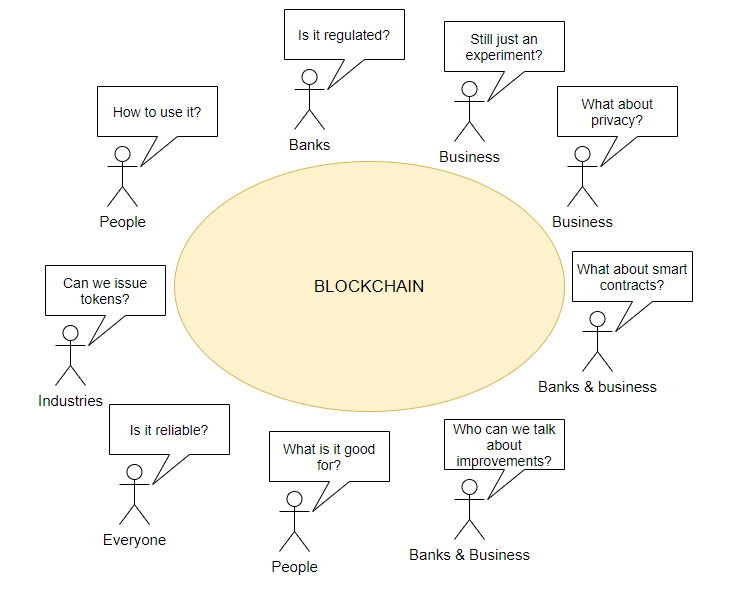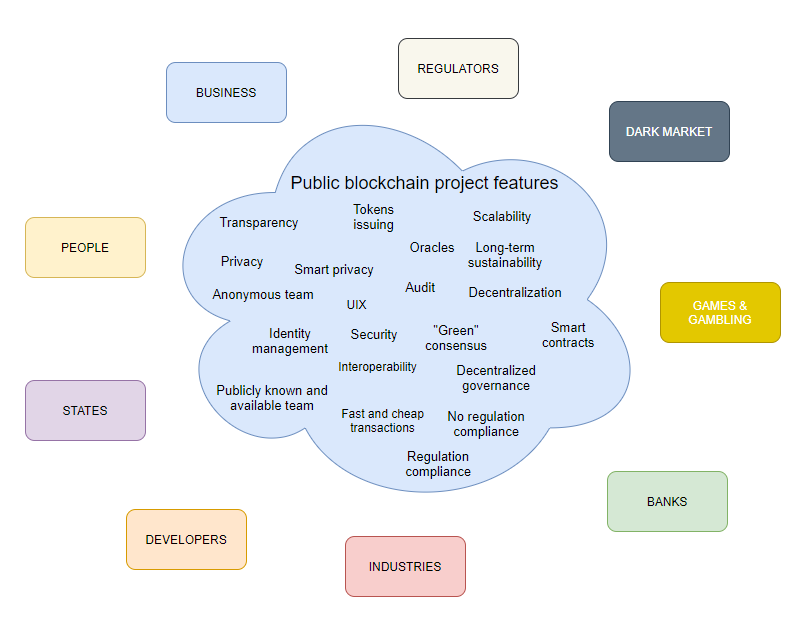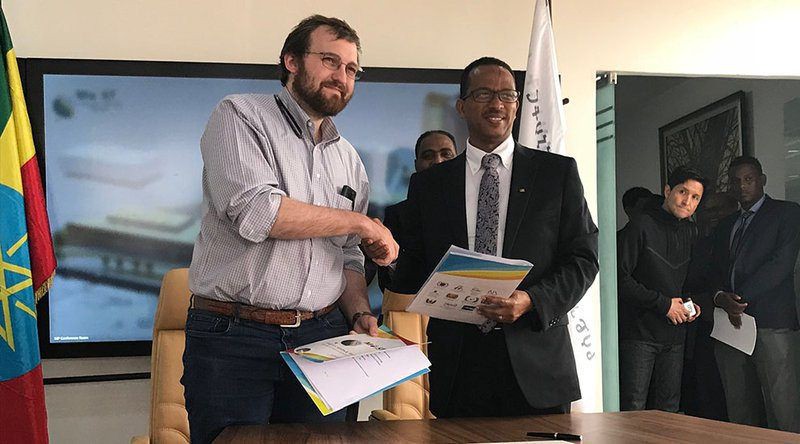
Why people hesitate with the adoption of blockchain
Blockchain technology came into the world as a public network maintained by people for people. Today, there are many projects that are fundamentally different and they attract users accordingly. But who are these users, and how do they choose the blockchain that suits their needs the best? Users can be ordinary people, entrepreneurs, industries, banks, or even states. Obviously, different groups of people will require different blockchain characteristics and functionalities. Some projects focus on one purpose only. Other projects are more versatile and can serve multiple purposes. Yet people have not massively adopted the blockchain.
Let's ask why people have not yet adopted the blockchain. We would find more reasons:
- The first blockchain projects came into the world as experiments and they are far from production quality. Blockchain is in principle a global network, but most projects do not meet the high-quality regarding scalability, security from the point of users, or reliability. In terms of user-friendliness, current projects are far from perfect. The hardware wallet allows users to keep cryptocurrencies securely stored. But sending is still quite dangerous and if you make a mistake, there is no way back.
- Projects do not have the necessary set of functionalities and capabilities required by different groups of people. For example, business requires high standards for data security and privacy. However, the requirement to make the audit still applies. Without fulfilling these requirements, the public blockchain is unusable for companies and banks. An open ledger is an obstacle for usage not only for business but also for ordinary people. Everyone is entitled to privacy. A project offering 100% private transactions can suit only to a limited group of people. A business may require that a transaction can be verified by multiple partners. For example, if Alice sends a token to Bob, Carol can verify it. Dave, however, cannot see this transaction. Bob may be a seller of goods, and Carol in the role of the state will take a toll.
- To make the projects more usable, they are being modified on the fly. In the case of blockchain, however, these improvements take a lot of time. Projects often do not have the necessary number of developers and researchers in their teams to be able to solve problems quickly.
- Some teams have often underestimated the initial market research. They did not think about who would use the projects and how. The team did not know the exact requirements of future users. They hoped they could just deliver what they considered useful. However, different user groups have different requirements. Teams also often underestimated the quantity and quality of existing competing projects. Now we can see a lot of projects that do essentially the same thing. Exceptionally, some project outweighs the competition. If the project does not offer any major and visible competitive advantage today, the chances of success are very low.
- Legal uncertainties and the differing attitudes of states to cryptocurrencies also do not help adoption. Many people are not interested in adopting it simply because they consider it illegal. Some institutions will not consider crypto projects unless it is clear that they will not have problems in the future.
The focus of projects directly influences the way of adoption. Private coins that do not offer additional functionality will be found by users themselves. As we have seen in the second case, in terms of business and the possible use of projects at the national level, the boundaries of privacy need to be clearly defined. Because requirements may vary in different use cases, the project should allow for flexible privacy settings. Here, teams have basically two ways to deal with the problem. Make the project very versatile, or talk to representatives of business, banks, and governments to clarify system requirements regarding privacy. This is only true if the team decides to work with regulators. This may not always be the case.

Most projects are not ready for mass adoption. We have just given a few most discussed reasons, and certainly, there would be more. There are also projects that work with a private version of blockchain. This approach addresses the shortcomings of the public blockchain projects. Private blockchains have no problem with scalability and privacy. All authentication nodes are operated by partners and data protection is higher than in a common database. Trust works only between partners, not from outside. In this article, we will not deal with private blockchain projects.
The Cardano project team deals with all the details of network deployment. The team wants to launch the main-net in production quality. The project will be ready for use. The team does not want to launch the main-net and then say that it is only an experiment and continue to work on key functionalities. It is clear to the team that in order to succeed in the competition of other projects, it must deliver a first-class product including solved scalability, privacy, secure language for writing smart contracts, and other things. The project will offer functionalities and capabilities that can compete and even outperform existing solutions. Cardano is a project that is open to everyone. It can be used by ordinary people, businesses, industries, banks, and states. Regarding regulations, the team will do its utmost to ensure the privacy of users while meeting the stringent demands of regulators. Cardano has no ambition to smash existing structures, but to bring more reliability, fairness, and transparency. Changes may not always appeal to everyone, as some businesses will be disrupted.
What teams can do for adoption
Understandable requirements can only be defined by mutual understanding between the team and future users of the system. There is a good chance that if the team meets the requirements and delivers the system that users want, the system will actually be used. This is very important for adoption. If you think more about it, this is probably one of the best ways to achieve mass adoption. Let's explore what teams can do to increase the adoption of their projects.
- If the project is intended only for ordinary people who need it and the team doesn't really care much who will eventually use it, it doesn't have to do almost anything. The team believes that the project has such great features that people will love to use it. The team is not afraid of competition and fully believes in giving people exactly what they want to use. It can be true or not. Of course, the team can listen to the community and improve or even change some parts of the project. However, it is a reactive approach. Users serve as a test group.
- The project has similar properties to another existing project. It is not fundamentally different from the competition and it might copy it to a certain extent. The team can bet on better project quality or marketing. Or both. This may work. However, the result is very uncertain. If the existing competition fails, this project will probably fail as well. If the competition is always one step ahead, the team is in the role of constantly catching up. The team delivers better functionality than competitors in rare cases. If it happens, it can attract a few users from the competition.
- The team will do a good survey. It asks all future users and/or partners what properties they want to use and what their demands are. If the project is to serve more groups of people, some intersection needs to be found. People are likely to benefit from the project if the requirements are met.
- From the beginning, the projects can cooperate with a partner and create a tailor-made project. So it targets a specific group of users. There is a chance that if the project serves one partner well, there will be others. This type of project does not always strive for mass adoption.
- The team manages to make a project that beats the existing competition by its quality or characteristics. This may happen, for example, with some fundamental scientific discovery. Much depends on the extent to which existing projects are adopted and established. In the case of technology, however, it is likely that some people will move to a better alternative in the market.
- Regulators can decide that projects have to meet particular requirements to be in line with rules. If they do not comply with the regulations, they will be considered illegal. There will be projects that are not interested in complying. Other projects, on the other hand, are waiting for this. The approach of teams differs depending on who the target group is for them.
This is not a complete listing of all options. Individual options could be combined in various ways. It can happen that the approach of a team change in time just because of striving for higher adoption.
There are projects where the team is not interested in being publicly known. These are mainly first-generation projects. There is an effort to convince people that the project is also decentralized at the level of development and management. Everyone can theoretically change an open-source project. What is crucial, however, is how it is decided to incorporate the proposed change. These processes cannot always be completely transparent and suitable for business. On the other hand, we have projects that are open to any debate about the project. Teams work with future partners and regular users. It is generally known who the representatives of these teams are and how they can be contacted.
Each approach suits a different project. With the complexity of the project and the broader focus on problem-solving, the demand for communication is increasing. In some cases, specific details need to be addressed. This can then affect the usability rate in different use cases.
A cryptocurrency implemented by a mere transaction system does not need to address the complex details that a business needs. In addition, the team longs to remain anonymous and get lost in the crowd of developers. This is especially true for anonymous cryptocurrencies. On the contrary, this cannot apply to platforms. The platforms will be used by developers. Developers can build some business logic for companies, banks, or states. The team must, therefore, listen carefully to all requests and address them.
The public network must be trusted. But the question is for whom. A certain group of people will trust the project with an anonymous team. This is totally inadequate for certain entities that need to have contact with the team in case of problem-solving and new requests.
At the moment, it is not clear which approach is better for adoption. Network and team decentralization are two completely different things. The network consensus and its decentralization is completely independent of the team. The team is not necessarily decentralized through the effort to remain anonymous. Behind each project is always a group of specific developers who will have a strong say. In addition, with the increasing adoption of projects, even wannabe anonymous teams will become more publicly known. If the team is to be decentralized at the team level, it is necessary to work on governance. The team will always be centralized to some extent. So it is not important WHO will make changes to the code, but WHAT will it be. Interested people should be able to influence WHAT will be done. However, it is also possible to decide WHO.

Cardano is a social and financial operating system. It is a platform that offers versatility and programmability. It can serve a wide range of people and groups. People's needs vary greatly depending on the area in which they live. People in Western developed countries have a good infrastructure and financial system at their disposal. This is not to be said about people in developing countries, which often lack land registers or a quick way to pay for electricity. To this day, people in some countries have to stand in line just to pay their bills physically at the office. Today, cryptocurrencies to Western people serve mainly as speculative investments or some manifestation of revolt against the current system. Slowly, some solutions are pushing through in the real business. In developing countries, blockchain has much greater potential for improving the quality of life. A completely new infrastructure can be built on the blockchain. But this is not going to be a revolution. The teams must communicate directly with government representatives and ask them about specific problems. He must then try to solve these problems. If they succeed, millions of people can quickly adopt a blockchain. This often requires a connection to the physical world. Working with people's real identities must not be an obstacle.
In South Africa, the South African National Blockchain Alliance (SANBA) was established. South African countries have decided to use blockchain technology to catch up with people living in western countries in terms of vital infrastructure. SANBA is a partnership between the state, the business community, academia, and civil society to finding a way how to use blockchain in South Africa.
The Cardano Foundation is part of this initiative and will be involved in developing this corner of the world. The team is convinced that Cardano can make a significant contribution and help with the adoption of the blockchain.

The Cardano Foundation is also working with other developing countries. Interestingly, the Memorandum of Understanding (MOU) was signed with the following countries: Mongolia, Georgia, South Korea, and Ethiopia.
Summary
Today's article was an overview of the current state of adoption of blockchain. We wanted to show you how diverse adoption can be and that individual projects never have a chance to meet the needs of all groups of people. Cardano still has a great chance to succeed and the Cardano Foundation team is working hard on adoption. Charles Hoskinson also helps them in this activity. Cardano chose a path of cooperation, transparency, and fair chances for everybody in the ecosystem.
Source: Cardano adoption will rock
 Cardano Shelley: How to stake in Daedalus
Cardano Shelley: How to stake in Daedalus The Cardano Protocol is well prepared for the Future
The Cardano Protocol is well prepared for the Future Security budget of the Cardano project
Security budget of the Cardano project About Cardano Pledging
About Cardano Pledging